|
Family: Amaryllidaceae
[= Agapanthaceae, Alliaceae]
Life
> eukaryotes >
Archaeoplastida >
Chloroplastida
>
Charophyta > Streptophytina > Plantae (land plants)
> Tracheophyta (vascular plants) > Euphyllophyta > Lignophyta (woody plants)
> Spermatophyta (seed plants) > Angiospermae (flowering
plants)
> Monocotyledons > Order: Asparagales
About 73 genera and 1605 species (warm temperate
and tropical regions worldwide), of which 21 genera and 263 species native to southern Africa (the region with the highest
diversity of amaryllids in the world). An additional three genera and four species
are
naturalised, and an additional 13 genera and 43 species are cultivated in southern Africa.
Genera native to southern Africa
List from Snijman (2000), Meyer (2000) and
Plants
of Southern Africa - an Online Checklist (SANBI).
Agapanthus
Six species, all endemic to southern Africa. Previously placed in the
Agapanthaceae. |
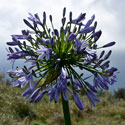 |
Allium
There are about 550 species worldwide, most of them
occurring in the northern hemisphere. Allium dregeanum is the only
species thought to be native to southern Africa although there is some doubt
that it originates here. Allium triquetrum (Three-cornered leek) is
naturalised in the region and an additional 12 species are cultivated,
including leek,
onion, shallot,
chives
and garlic. Previously in Alliaceae. |
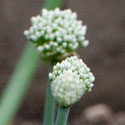 |
Amaryllis
Two species, endemic to the Northern Cape
and Western Cape, within the winter-rainfall region. |
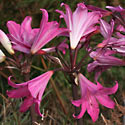 |
Ammocharis
Seven species, native to sub-Saharan
Africa, with six species native to southern Africa. |
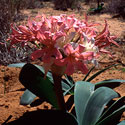 |
Apodolirion
Six species, all endemic to southern
Africa. |
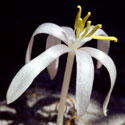 |
Boophone
Two species, both native to southern Africa.
Boophone disticha is widely distributed in sub-Saharan Africa. |
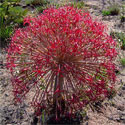 |
Brunsvigia
Eighteen species, all endemic to southern Africa. |
 |
Clivia
Six
species, all endemic to southern Africa. |
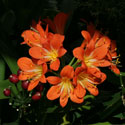
|
Crinum
About 65 species worldwide, found
mainly in the tropics, with 22 species native to southern Africa. An
additional four exotic species are cultivated in the region. |
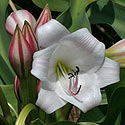 |
Crossyne
Two species endemic to
the winter-rainfall regions of the Western Cape and Northern Cape, in South
Africa. |
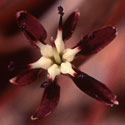 |
|
Cryptostephanus
Two species native to southern Africa. |
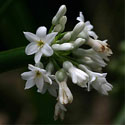 |
Cyrtanthus
Fifty-one species
are native to southern Africa and there is a further species (Cyrtanthus
welwitschii) occurring further north, its distribution including
Angola and Malawi. Bulb contains non-lethal haemolytic saponin and
alkaloids, and causes vomiting and diarrhoea if eaten. |
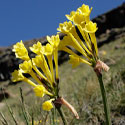 |
Gethyllis
Twenty-five species, endemic to
southern Africa, occurring in semi-arid regions. |
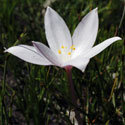 |
Haemanthus
Twenty-two species, endemic to
southern Africa. |
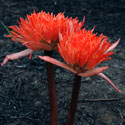 |
Hessea
Thirteen species, all endemic to
southern Africa. |
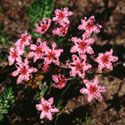 |
|
Namaquanula
Two species: Namaquanula bruce-bayeri and
Namaquanula etesionamibensis. |
|
Nerine
Bulbs contain poisonous alkaloids, but not
usually enough to cause death if eaten. Twenty-four species, all endemic to southern Africa. |
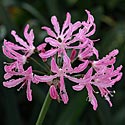 |
Pancratium
About 20 species, found in
the Mediterranean region, southern Asia, the Canary Islands and Africa.
Pancratium
tenuifolium is the only species native to southern Africa, found in
Namibia, Botswana and the Northern Province. In addition, Pancratium
canariense from the Canary Islands, and Pancratium maritinum from
the Mediterranean region, are cultivated in southern Africa. |
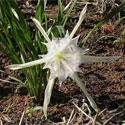 |
Scadoxus
Nine species, native to
Africa, with four species native to southern Africa. Bulbs can contain toxic alkaloids. |
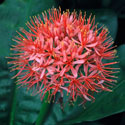 |
Strumaria
Twenty-seven species, endemic to
southern Africa. |
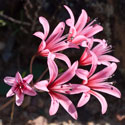 |
Tulbaghia
An African genus concentrated in southern Africa where 22 species have been
recorded. Previously in Alliaceae. |
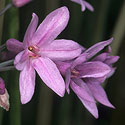 |
Genera naturalised in southern Africa
|
Habranthus
Habranthus robustus is naturalised in the region.
In addition, Habranthus tubispathus is cultivated in the region. |
|
Nothoscordum
There are 18 species
worldwide, found mainly in the Americas.
Nothoscordum
x borbonicum is an introduced weed in southern Africa, often found
growing in garden lawns and along roads. It is difficult to control because
the parent plant produces many small bulblets which get left behind when the
plant is pulled out. Previously in Alliaceae. |
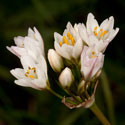 |
Zephyranthes
Zephyranthes
grandiflora originates from Central America and has become established
in coastal areas of KwaZulu-Natal. An additional four species are cultivated
in southern Africa. |
|
Other genera, cultivated in southern Africa
List from Glen (2002). The species name is listed for
genera with only one species recorded in southern Africa. Doryanthes now included in
Doryanthaceae in the order Asparagales.
Calostemma
purpureum
Native to Australia. |
|
Chlidanthus fragrans
Native to Peru. |
|
Eucharis grandiflora
(Amazon lily)
Native to Colombia. |
|
Griffinia
An unidentified species recorded as being cultivated in southern Africa. |
|
Hippeastrum
About 90 species and over 600 hybrids, native from Mexico to Argentina, and
the Caribbean. Two species and one hybrid are cultivated in southern Africa. |
|
Hymenocallis
Sixty-three species, native to tropical and subtropical South America, with
four species cultivated in southern Africa. |
|
Ipheion uniflorum
Native to Uruguay and Argentina. Previously in Alliaceae. |
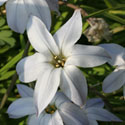 |
Leucojum aestivum (Summer
snowdrop)
Native from Europe to the Caucasus.
|
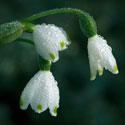 |
Leucocoryne ixioides (Glory of the sun)
Native to Chile. Previously in Alliaceae. |
|
Lycoris radiata
Native to Japan. |
|
Narcissus (daffodil genus)
About 27 species, native to Europe, North Africa and Asia, with five species
cultivated in southern Africa. |
|
Polianthes tuberosa
(Tuberose)
Native to
Mexico. |
|
Sprekelia formosissima
(Jacobean lily, Maltese cross)
Native to Mexico and Guatemala. |
|
See list of
important poisonous species in the Amaryllidaceae that are found in southern
Africa.
Publications
-
Glen, H.F. 2002. Cultivated plants of southern
Africa. Jacana, Johannesburg.
- Goldblatt, P. 1976. Chromosome cytology of Hessea,
Strumaria and Carpolyza (Amaryllidaceae). Annals of
the Missouri Botanical Garden 63: 314–320.
-
Meyer, N.L. 2000. Alliaceae. In: Seed Plants of
Southern Africa (ed. O.A. Leistner). Strelitzia 10: 569-570.
National Botanical Institute, Pretoria.
- Snijman, D. 1993. Review of the systematics of the
Strumariinae (Amaryllidaceae). Herbertia 48: 52–57.
-
Snijman, D.A. 2000. Amaryllidaceae. In: Seed Plants
of Southern Africa: Families and Genera (Ed. O.A. Leistner). Strelitzia
10. National Botanical Institute, Pretoria, pp. 570-576.
-
Snijman, D.A. & Linder, H.P. 1996.
Phylogenetic relationships, seed characters, and dispersal system evolution
in Amaryllideae (Amaryllidaceae). Annals of the Missouri Botanical Garden
83: 362-386.
- Vorster, P.J. & Spreeth, A.D. 1996. Leaf anatomy
and generic delimitation in South African
Amaryllidaceae. In: L.J.G. van der Maesen, X.M. van der
Burgt & J.M. van Medenbach de Rooy (eds), The
biodiversity of African plants. Proceedings of the 14th
AETFAT Congress: 513–516. Kluwer Academic
Publishers, Dordrecht.
Text by Hamish Robertson |
